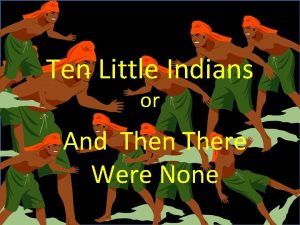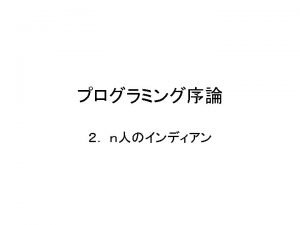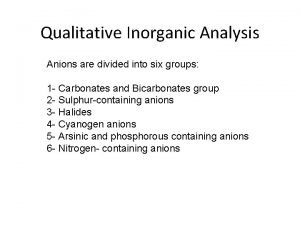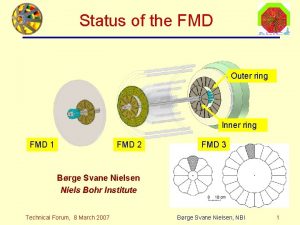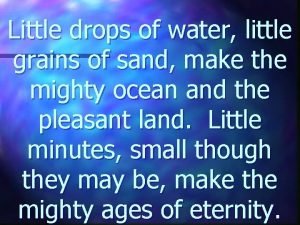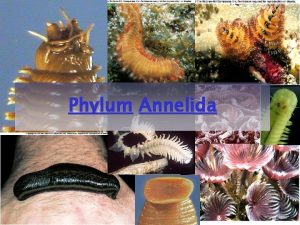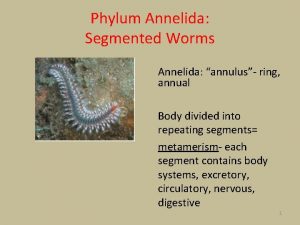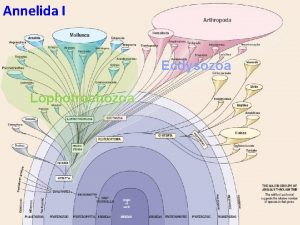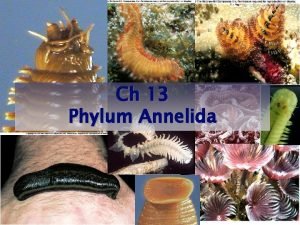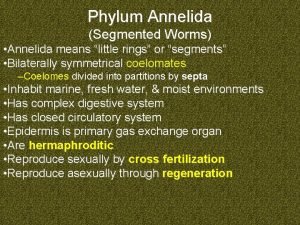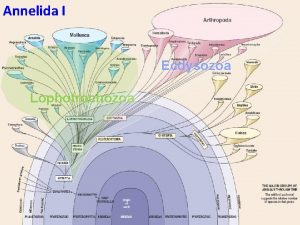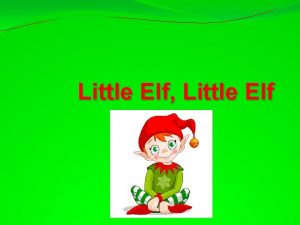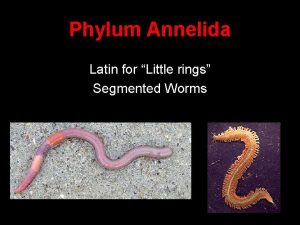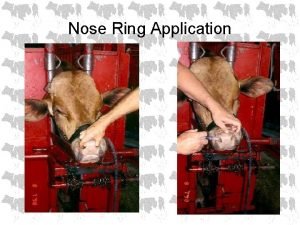ANNELIDA JEFFREY WIEDIYANTO ANNELIDA Latin meaning little ring











- Slides: 11

ANNELIDA JEFFREY WIEDIYANTO

ANNELIDA Latin meaning “little ring”, sometimes also called as segmented worms. EARTHWORM The animals that are classified as Annelids are segmented worms. ○ No legs ○ No skeleton ○ Have body that are divided into little segments Kingdom: Animalia There about 22, 000 species including rag worms, earthworms, and leeches. Order: Haplotaxida TO THE ECOSYSTEM: Without worms, plant would not be able to grow, as it helps fertilize, mix, and provide proper minerals to soil Phylum: Annelida Class: Oligochaete Subclass: Palpata Family: Acanthodrilidae Genus: Lumbricus Species: L. terrestris

ANATOMY (EARTHWORM) - - BODY - Metamerism - Are segmented which looks like many little rings joined together - Make them flexible and strong in its movement - Made out of 100 -150 segmented bodies - Structural function - Help them to move MUSCLE - Setae - Control the worm when moving through soil - They can relax or contract their muscles independently - Lengthen one specific area

3 CLASSES OF ANNELIDS 1. Polychaetes ▪ Marine ▪ Fan worms 2. Oligochaete ▪ Freshwater ▪ Terrestrial ▪ Earthworms 3. Hirudinea ▪ Leeches ▪ Marine ▪ Freshwater ▪ Terrestrial

Oligochaeta (COMMON EARTHWORM) ▪ Name means “few long hairs” ▪ Few setae per body segment ▪ Terrestrial and freshwater Kingdom: Animalia Phylum: Annelida Class: Clitellata Subclass: Palpata Order: Haplotaxida Family: Acanthodrilidae Genus: Lumbricus Specis: L. terrestris

Polychaetes (EUROPEAN FAN WORM) Fan Worms are tube dwellers that have tentacles for filter feeding ▪ Name means “many long hairs” ▪ Many setae per body segment ▪ Mostly marine annelid Kingdom: Animalia ▪ Divided into two groups Phylum: Annelida ▪ ▪ Free moving forms Class: Polycheta ▪ Tube dwelling forms Subclass: Palpata Parapodia used for Order: Canalipapata Crawling Suborder: Sabellida ▪ Swimming Family: Sabellidae ▪ Feeding Genus: Schizobranchia ▪ Specis: S. insignis Rag worms are mainly omnivorous but many are active carnivores. Kingdom: Animilia Phylum: Annelida Class: Polychaeta Subclass: Errantia Order: Phyllodocida Family: Nereididae Genus: Nereis Species: Nereis Pelagica

ANATOMY (EUROPEAN FAN WORM) - BODY Their body is divided into segments and only the first two segments are different from the rest First Head Eyes Two jaws Second Nuchal organ Nose Track prey Fish Small shrimp Other worms

Hirudinea (LEECHES) ▪ Hirudinea means leeches ▪ Mostly freshwater, some marine and terrestrial ▪ Consume blood ▪ No parapodia or setae ▪ Clitellum present Kingdom: Animalia Phylum: Annelida Class: Hirudinea Order: Arhynchobdellida Family: Hirudidae Genus: Hirudo Specis: Hirudo medicinalis

ANATOMY (MEDICINAL LEECH) - - BODY Cylindrical bodies Divided into three segments The top part Kingdom: Animalia Black or brown color They don’t really have muscle Phylum: Annelida Therefore they could only swim or attach themselves into something using their sucker. Class: Hirudinea SUCKER Order: Arhynchobdellida Posterior Family: Hirudidae To attach themselves Anterior Genus: Hirudo To eat Specis: Hirudo medicinalis

REPRODUCTION Polychaeta and Oligochaeta can both reproduce sexually and asexually, while leeches can only reproduce asexually. Asexual reproduction does not involve the formation of gametes (sperm and eggs), it is by budding

BIBLIOGRAPHY ❑ http: //www. nhc. ed. ac. uk/index. php? page=24. 25. 312. 329 ❑ https: //www. uas. alaska. edu/arts_sciences/naturalsciences/biology/tamone/catalog/annelida/Sc hizobranchia_insignis/taxonomy. html#Phylum_Annelida: ❑ https: //www. sas. upenn. edu/~rlenet/Earthworms. html
 Ten little indian boys poem
Ten little indian boys poem 1 little 2 little 3 little indian
1 little 2 little 3 little indian How are anions divided into groups
How are anions divided into groups Constriction ring uterus
Constriction ring uterus Inguinal area
Inguinal area Superficial inguinal ring
Superficial inguinal ring Ding dong ding dong christmas bells are ringing
Ding dong ding dong christmas bells are ringing Ring christmas bells ring them loud
Ring christmas bells ring them loud Inner ring and outer ring
Inner ring and outer ring Resilient packet ring
Resilient packet ring What are quantifiers
What are quantifiers Little drops of water, little grains of sand meaning
Little drops of water, little grains of sand meaning
